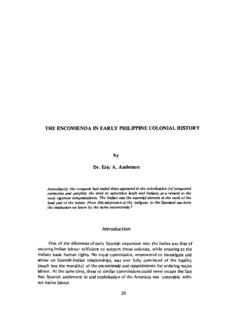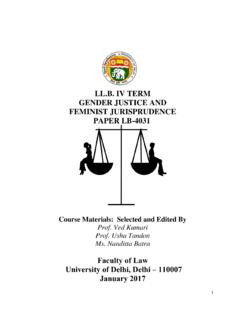Transcription of AMERICAN COLONIAL EDUCATION AND ITS IMPACT ON
1 AMERICAN COLONIAL EDUCATION AND ITS IMPACT ON THE STATUS OF FILIPINO women Carolyn Israel Sobritchea, This article analyzes the effects of AMERICAN COLONIAL educa-tion on Filipino women . It discusses how the EDUCATION policies and programs influenced the pattern of female participation in economic production during the nearly fifty years of AMERICAN COLONIAL rule, as well as female entry in non-domestic activities. The system of public EDUCATION introduced in the country by AMERICAN colonialism had both positive and negative effects on Fili-pino women . On the positive side, it substantially increased their level of literacy and gave daughters of countless poor families the opportunity to break away from traditional gender-related roles.
2 AMERICAN COLONIAL EDUCATION also provided Filipino women , parti-cularly those of middle-class background, the necessary skills, ability and confidence to fight for legal and political adulthood and assume responsible roles in public life. However, these developments must be seen within the framework of the overall thrust and objectives of AMERICAN colonialism. This article argues that the kind of edu-cation the Filipino women 1 eceived during the AMERICAN COLONIAL period p1 imarily prepa red them to respond to the demands of the COLONIAL bureaucracy and economy. The public schools did not ac-tively promote gender equality; on the contrary they peddled the same patriarchal ideas and systems of gender relations that Spain brought to the Philippines.
3 Even if the level of female literacy in-creased, therefore, and more women gained access to new types of work and careers, these were not enough to bring them on equal footing with men. AMERICAN COLONIAL EDUCATION shaped the consciousness of the Filipino women in a manner that, ultimately, did not bring the country and herself much good. With the fear of the devil and the restrictive influence of the convento morality behind her, she meta-morphosed into a "modern" woman, comfortable with all the trap-70 AMERICAN COLONIAL EDUCATION 71 pings of western life and ethos as well as with traditional patriar-chal norms and practices.
4 She more than willingly assumed her role in the production line even if doing so meant subordination to men. The female product of AMERICAN COLONIAL EDUCATION learned to exercise her right to cast the ballot, but only to root for sexist male political candidates or endorse political programs discrimina-tory to her own interest. Finally, by being in the forefront of edu-cation as teachers of millions of school children, she played a most decisive role in carrying on the task left behind by the Thomasites, that of propagating and maintaining COLONIAL consciousness in the country. Spanish Legacy Contrary to popular belief, the Americans were not the first to bring the concept of universal primary EDUCATION to the Philip pines.
5 An EDUCATION decree passed in 1863 mandated the establish-ment of a complete system of EDUCATION in the country consisting of elementary, secondary and tertiary levels. Notable among the provisions of the decree were the call for compulsory EDUCATION for children between the ages of seven and twelve and state support for elementary textbooks and basic :5chool supplies. The decree also mandated the establishment of teacher training schools and train-ing centers of arts and trades in Manila and Iloilo as well as a nau-tical school, also in Manila. Spanish was made the official medium of instruction in all levels. Despite the well-meaning intentions of the aforementioned edu-cational reform, it did not significantly improve the level of literacy in the country.
6 Many aspects of the decree were not adequately enforced because of strong resistance from Catholic priests and lack of funds. Nevertheless, state-supported village schools were estab-lished which, by 1866, numbered 1474 (Mendoza-Guanzon, 1928:19). Forty-three percent of these schools were opened exclusively for girls. When the Americans occupied the Islands in 1898, the total number of primary schools reached 8,167 and the total student po-pulation was 200,000 (Isidro, 1952: 15-16). The first socio-econo-mic census taken at the turn of the century estimated the female literacy rate at only ten percent in contrast to the male rate of nearly thirty percent (Reyes, 1951 :2}.)
7 The curriculum at the primary level consisted of reading, writ-ing, arithmetic, geography, Christbn doctrine, Spanish grammar and 72 ASIAN STUDIES music. Boys were given basic training in agriculture and the girls, in needlework. Mendoza-Guanzon (1928: 17-18) described that village classes generally consisted of two sessions a day, the first was from eight to eleven in the morning and the other, from two to five in the after-noon. Learning was essentially done by rote memory and pupils were heavily subjected to verbal and physical forms of discipline and punishment. Boys and girls alike were made to stand still for hours with arms raised forward; they were whipped with the use of wood, bamboo stick or leather strap.
8 At other times, they were pinched or punished. These practices, she claimed, kept the schools almost deserted. Instead of attending classes, children often stayed home and helped with farm and household chores. Before the EDUCATION reform of 1863, elementary training was left entirely in the hands of priests or curates of the parish (Philip-pine Stud1es Program of the University of Chicago, 1956). There were few schools and practically all were for the children of the Spaniards, mestizos and rich natives. Fresnoza (1950 :31) described the program of EDUCATION undertaken by the Catholic church during the early part of Spanish COLONIAL rule thus: The course of study consisted of reading by the alphabet and syllable method, the learning of sacred songs and music, a little arith-metic, and writing for the advanced students.
9 The contents of the materials to be read were religious, such as the common prayers required for the sacraments of confession and communion and the cathechism of the Christian doctrines. Classes were ungraded and the children were required to attend the schools until they had learned to say the prayers required for the sacraments of confession and communion and memorized the Doctrina Cristiana. Instruction was given in the dialect of the com-munity. Spanish was taught to the more brilliant students, especially to the sons of the principalia (upper class). The EDUCATION of the females was very minimal. In fact, it limited to daughters of well-to-do families and to the learning of rudimen-tary reading, writing, arithmetic, religion and needlecraft.
10 Formal training beyond the primary grades were generally a male privilege. For the most part of the Spanish period, the majority of secondary and vocational schools as well as colleges were exclusively for males. There were a few institutiolfs of higher learning for girls but they were meant only for daughters of Spaniards and other local elites. The earliest of such schools wa :he Colegio de Sta. Isabel which AMERICAN COLONlAL EDUCATION 73 was founded in 1632. The others were Colegio de Sta. Catalina (1696), Beaterio de San Ignacio (1699), Colegio de Sta. Rosa (1750), Escuela de Maestras ( 1864), Colegio de la Immaculada Concepcion (1868) and Colegio de San Jose de Jaro (1872).






